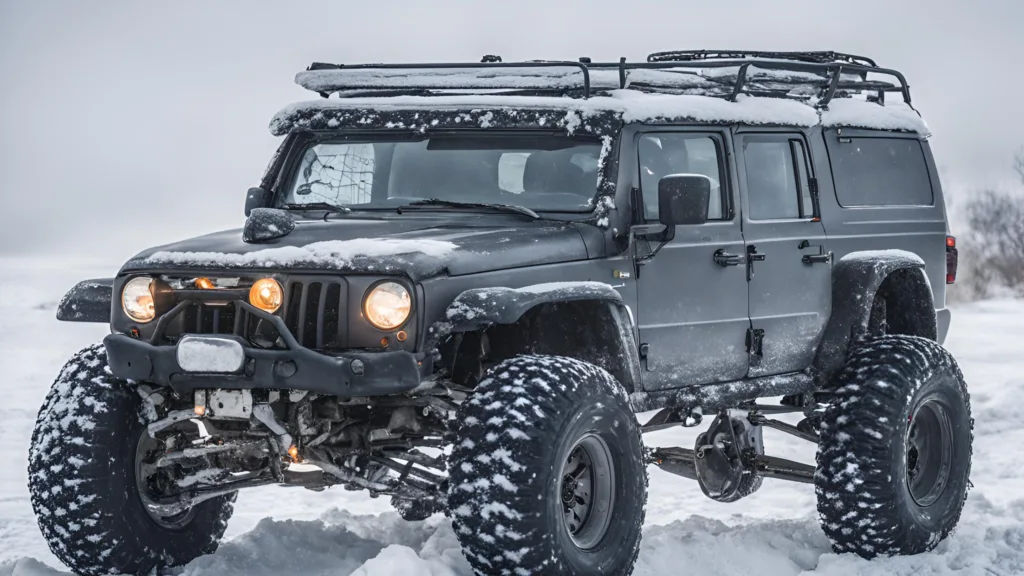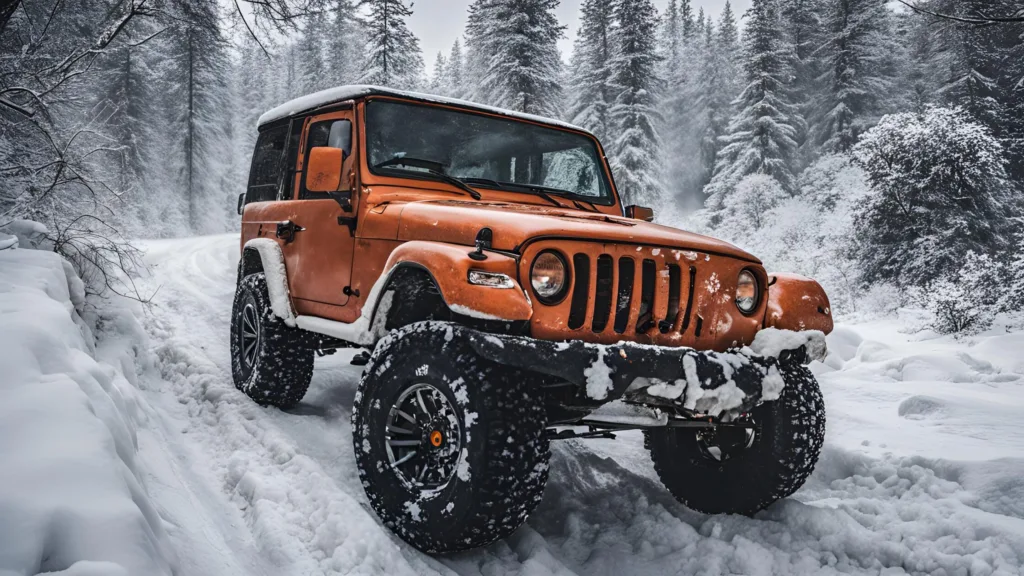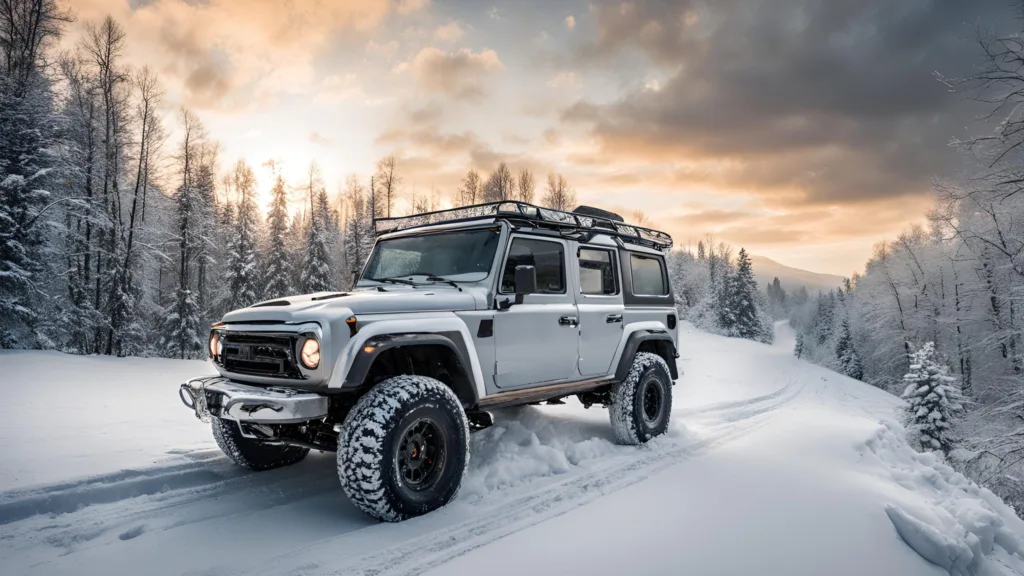Winter Off-Roading Safety extra safety precautions due to less traction and frozen terrain. Always equip your vehicle with winter-specific gear and emergency supplies.
As the chill of winter sets its sights on the adventure trails, many off-roading enthusiasts gear up for the distinct challenges posed by the season’s snow, ice, and slush. Ensuring a safe off-roading experience during these colder months is not just recommended; it’s essential.
Preparing your vehicle for the harsh winter conditions involves a checklist that ranges from specialized tires to antifreeze levels. It’s crucial to understand the limitations of both your off-road vehicle and your driving skills when faced with an unpredictable winter landscape. Keeping oneself educated on the latest off-roading techniques and staying updated on weather forecasts can be lifesaving. Initiating every winter off-roading trip with these considerations in mind helps in creating not only exhilarating memories on the trails but also secure ones.

The Lure Of Winter Off-roading
The crisp air, the pristine blanket of snow, and the untouched trails beckon the adventurous at heart. Winter off-roading presents a siren call to those seeking a fresh challenge and thrilling experiences amid breathtaking landscapes.
Thrills On Snow And Ice
The thrill of winter off-roading lies in its unpredictability and the unique sensation of tyres crunching over fresh powder. Explorers experience the exhilaration of navigating through the serene white wilderness, where normal roads end and the true adventure begins. From the glitter of icy paths to the soft hush of snowy forests, the journey is as captivating as it is thrilling.
- Gliding over frozen lakes, pushing the limits of traction and skill.
- Daring hill climbs, where each ascent is a gamble against slippery slopes.
- Racing with the wind, leaving a cloud of snowflakes in your wake.
Unique Challenges Of Cold-weather Terrain
Winter terrains require rigorous preparation and a respect for Mother Nature’s icy grip. The elements introduce variables that demand skill, patience, and resilience.
| Challenge | Preparation Tips |
|---|---|
| Reduced Visibility | Equip powerful lights, use fog-resistant lenses |
| Deep Snow | Carry shovels, traction mats, use appropriate tyres |
| Ice Patches | Install studs, lower tyre pressure for better grip |
| Cold-Weather Breakdowns | Perform pre-trip checks, carry emergency kits |
Beneath the blanket of snow, unforeseen obstacles lurk, ranging from hidden rocks to sudden dips in the terrain. The cold can sap battery life and make metal brittle. Each turn can lead to awe-inspiring views or test the limits of one’s off-roading acumen.

Essential Gear For Winter Adventures
When the landscape transforms into a winter wonderland, off-road adventurers need to gear up accordingly. Tackling trails covered in snow and ice demands specialized equipment to ensure safety and success. Read on for the essential gear that will keep you moving on your coldest journeys.
Tires Suited For Snow And Ice
Winter off-roading starts with the right tires.
- Snow tires come with deep treads for traction.
- Studded tires bite into ice for a secure grip.
- All-terrain tires should be marked with a snowflake symbol.
Always check tire pressure as cold weather can cause fluctuations.
Emergency Supplies For Cold Weather
In case of emergencies, the following supplies are vital:
| Supply | Use |
|---|---|
| Blankets | Warmth |
| Shovel | Clearing snow |
| Flares or LED lights | Visibility |
| Extra food and water | Sustenance |
| First-aid kit | Medical emergencies |
Don’t forget extra layers of clothing and a fully charged power bank for your devices.
Preparing Your Vehicle
Winter off-roading brings a mix of excitement and challenge. Before setting out, preparing your vehicle is vital. Your off-roader must handle icy trails and frosty climbs. This guide shows you how to gear up for a safe, winter off-road adventure.
Checking Fluids And Batteries
Low temperatures impact your vehicle’s fluids and battery performance. Follow these steps:
- Check engine oil levels: Ensure the oil is high-quality and suited for cold weather.
- Inspect antifreeze: The correct antifreeze mix prevents freezing.
- Assess brake and transmission fluids: They must be at recommended levels.
Remember, batteries lose power in the cold. Test your battery and keep jumper cables ready.
Protecting The Undercarriage
The undercarriage of your vehicle is crucial. It faces snow, ice, and salt on winter trails. Protect it with these tips:
- Apply rustproofing: It guards against corrosion.
- Install skid plates: They shield important components.
Perform a thorough inspection of the undercarriage before and after each trip.
Navigating Through Winter Trails
Winter off-roading thrills and challenges even the most experienced adventurers.
Crisp air and snowy landscapes create a unique driving environment.
Ready for this excursion?
Stay safe and enjoy the ride by following these essential tips.
Understanding Snow Conditions
Snow behaves unpredictably under different conditions.
It’s crucial to know what lies beneath the white blanket.
Snow density and depth can affect vehicle traction and control.
- Powdery snow: Light and easy to displace, but may hide ice.
- Wet snow: Packs well, offering more traction, yet can be heavy.
- Ice layers: Require specialized tires or chains for grip.
Always test the ground. Start with gentle maneuvers to understand the snow’s nature.
Respecting Nature And Weather Alerts
Respect for nature is paramount.
Always check forecasts before setting out.
Sudden changes in weather can create hazardous conditions.
Use trusted sources for updates while on the trails.
A reliable weather app on your phone can be a lifesaver.
Make note of warning signs like darkening skies or increasing winds.
These might signal an approaching storm.
React swiftly to weather alerts.
Safe Driving Techniques On Ice
Winter off-roading adventure is thrilling. But as temperatures drop, driving on ice becomes challenging. Knowing safe driving techniques on ice can make your experience enjoyable and secure. Let’s explore effective strategies for maintaining control of your vehicle in wintry conditions.
Controlling Skids
To control a skid on ice, stay calm. Quick reactions can cause your vehicle to lose control.
- Steer gently in the direction of the slide.
- Do not overcorrect your steering.
- Keep your eyes on your path, not the obstacles.
- Do not slam on the brakes. Gently ease off the accelerator.
- Switch to a low gear to help reduce speed smoothly.
Maintaining Momentum Uphill
Maintaining momentum is essential while driving uphill on icy surfaces. Use these tips to move up slopes without trouble.
- Approach the hill at a steady, moderate speed.
- Avoid stopping on the hill.
- If you start to slide, ease off the accelerator, but do not stop moving.
- Use a higher gear to prevent wheel spin.
- Keep a steady pace until you reach the top.
Emergency Procedures And Rescue Planning
Exploring the winter wilderness through off-roading offers thrills and chills. Safety becomes paramount in these conditions. When planning your adventure, it’s vital to prepare for emergencies. This section covers crucial steps if you find yourself stuck and highlights effective signaling systems for rescue.
What To Do When Stuck
Off-roading in winter can lead to unexpected situations. Keep calm and follow these steps:
- Stay with your vehicle: It’s your best shelter and makes you more visible to rescuers.
- Conserve heat: Run the engine intermittently, ensuring an outdoor vent is clear of snow.
- Check your emergency kit: Use items wisely to maintain warmth and energy.
- Signal distress: Tie a bright cloth to your antenna or hang it from a window.
Setting Up Signaling Systems
A proper signaling system can be the difference between a quick rescue and hours of waiting. Do this:
- Use flares: Place them around your vehicle to draw attention.
- Flashlights or strobe lights are effective after dark.
- Make footprints: If safe, create noticeable markings in the snow.
- Whistles can alert rescuers nearby.
Remember, your preparations for emergencies are critical. Stay safe and enjoy your winter off-roading experience!

Frequently Asked Questions For Winter Off-roading Safety
What Safety Gear Is Needed For Winter Off-roading?
Winter off-roading demands specialized gear for safety and comfort. Essential items include thermal clothing, waterproof boots, gloves, and a winter-rated sleeping bag if overnighting. Don’t forget tire chains, a shovel, and a tow strap.
How Do I Prepare My Vehicle For Snow Trails?
Ensure your vehicle is winter-ready with a thorough maintenance check. Key areas include tire tread and pressure, antifreeze levels, and battery health. Install winter tires and carry emergency supplies, like a blanket, flares, and extra food and water.
What Are Top Winter Off-roading Tips?
Firstly, travel with a buddy vehicle to ensure backup in emergencies. Always keep extra fuel and follow marked trails to avoid getting lost. Drive slowly to maintain control on icy paths, and use low gears for better traction.
How To Handle Off-road Driving In Heavy Snow?
Handling heavy snow off-road requires torque management and maintaining momentum. Use a low gear and avoid sudden accelerations. If you get stuck, rock the vehicle gently back and forth or use recovery tracks to regain traction.
Conclusion
As the chill sets in, remember that safety is paramount in winter off-roading adventures. Always prep your vehicle, dress warmly, and stay informed. Embrace the thrill of snowy trails responsibly. Your excursions can be exhilarating and safe, paving the way for unforgettable memories in the winter wilderness.
Stay safe, and enjoy the ride!


